Coastal Flooding Hazard, Exposure, and Readiness of Buildings in Hong Kong in 2080–2100, and the Implications for Real Estate Management
Abstract
1. Introduction
1.1. Literature Review
Research Gap
1.2. Conceptual Models for Assessing Real Estate Flooding Risks
1.2.1. Components of Risk
1.2.2. Review of Assessment Method
1.3. Tools for Flooding Risk Quantification
1.3.1. Methods for Predicting Future Coastal Floods
1.3.2. GIS and ML as Tools for Risk Analysis
1.4. Loss Mitigation and Stakeholders
1.5. Research Aim and Objectives
- (a)
- What will be the exposure and hazard level of coastal flooding in Hong Kong at the end of the 21st century under different scenarios?
- (b)
- What are the characteristics of coastal flooding risks and preparedness of the buildings in Hong Kong?
- (c)
- How to reduce the potential loss through improving the current situation through real estate management measures regarding the future potential flooding risks?
- Understanding the spatial distribution of exposed area and hazard of coastal flooding in Hong Kong in 2080–2100 under SSP 4.5 and SSP 8.5.
- Assessing the flooding hazard, exposure, and readiness of buildings under the two SSPs and categorizing the buildings into several types by considering their risk profiles.
- Analyzing the representative risk profiles of building from the results, and hence, discussing implications for real estate management and adaption to 2100.
2. Materials and Methods
2.1. Assessment Framework Design
2.2. Data Collection and Preprocessing
2.3. Data Analysis
2.3.1. ESL and Return Period Estimation
2.3.2. Spatial Analysis: Magnitude and Readiness
2.3.3. Clustering Analysis
2.4. Research Approach
3. Results
3.1. Spatial Distribution of Flooding Risks
3.1.1. ESL Events
3.1.2. Coastal Flooding Exposure
3.1.3. Coastal Flooding Hazard Index
3.2. Analysis of Risk Characteristics
3.2.1. Result of Clustering
3.2.2. Quality of Clustering
4. Discussion
4.1. Characteristics and Sources of Coastal Flooding Risks
4.2. Recommendations for Stakeholders
4.3. Limitations and Future Research
5. Conclusions
Author Contributions
Funding
Data Availability Statement
Conflicts of Interest
Appendix A
| Method | Probability of Exceedence, P | Average Recurrence Interval, T |
|---|---|---|
| California | m/n | n/m |
| Hazen | (m − 0.5)/n | n/(m − 0.5) |
| Weibull | m/(n + 1) | (n + 1)/m |
| Chegodayev | (m − 0.3)/(n + 0.4) | (n + 0.4)/(m − 0.3) |
| Blom | (m − 3/8)/(n + 1/4) | (n + 1/4)/(m − 3/8) |
| Gringorten | (m − 0.44)/(n + 0.12) | (n + 0.12)/(m − 0.44) |
Appendix B
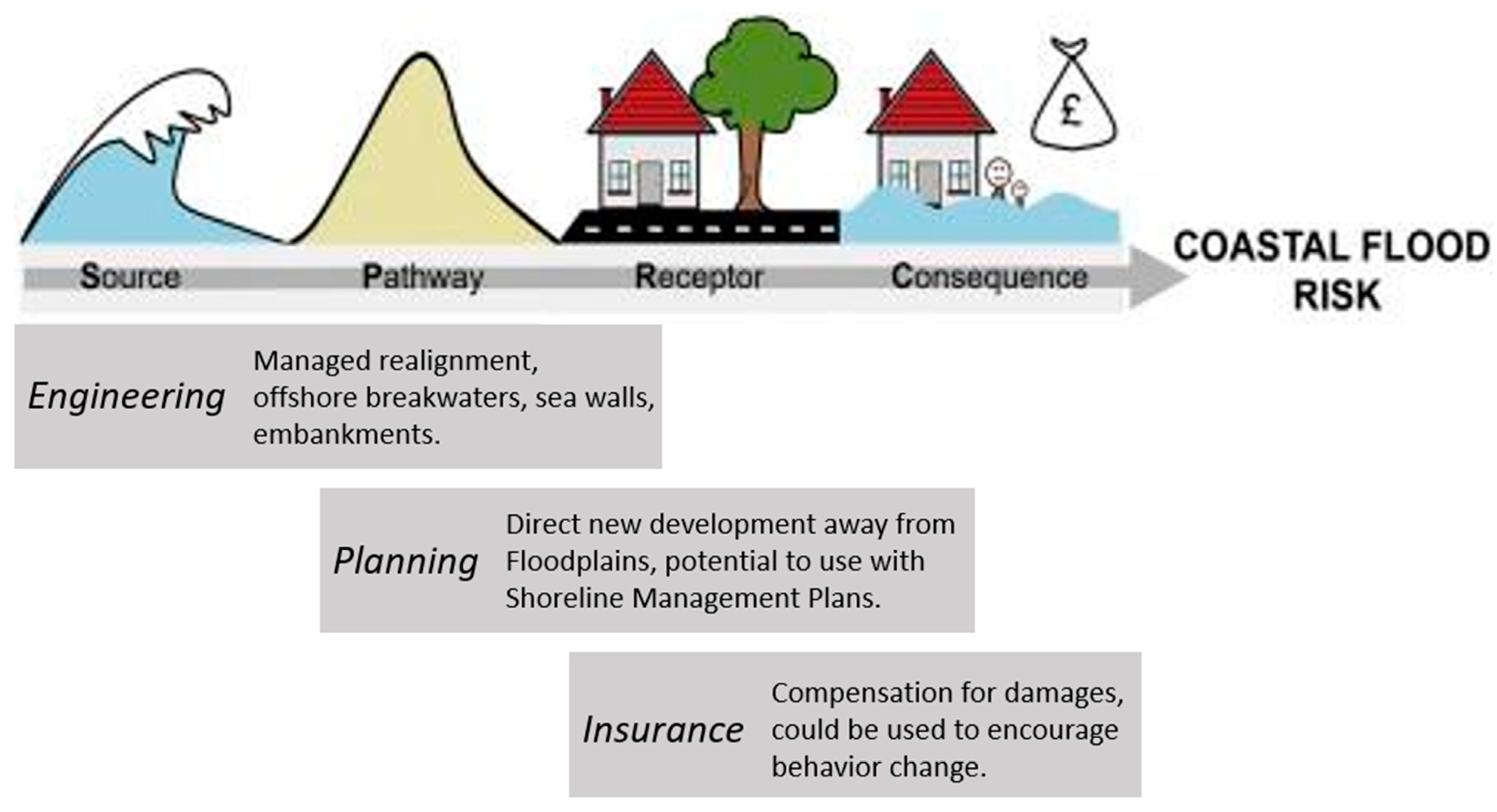
Appendix C
| Category | Data | Source | Type | |
|---|---|---|---|---|
| Flooding prediction | Future climate data under SSP4.5 and 8.5 | Sea level rise | (Fox-Kemper et al., 2021) | Numerical value |
| Historical climate data | Sea level record | (HKO, 2022b) | Numerical record | |
| Storm surge database | ||||
| Tide amplification | (Dominicis et al., 2020) | Numerical value | ||
| Risk assessment | Local data | 5 m digital elevation model | (Lands Department, 2021) | Shapefile |
| Location of tide observatory station | Manually recorded | - | ||
| Building | (Lands Department, 2021) | Shapefile | ||
| Dune restoration areas | Shapefile | |||
| Flooding control infrastructure | Shapefile | |||
| Mangrove | Shapefile | |||
| Sea grass bed | (AFCD, 2021) | Map | ||
| Green building | (HKGBC, 2021) | Building address | ||
| Landcover | (Lands Department, 2021) | Shapefile | ||
| Qualitative analysis | Qualitative data | Reports | - | - |
| Open websites | - | - | ||
| Policy documents | - | - | ||
Appendix D
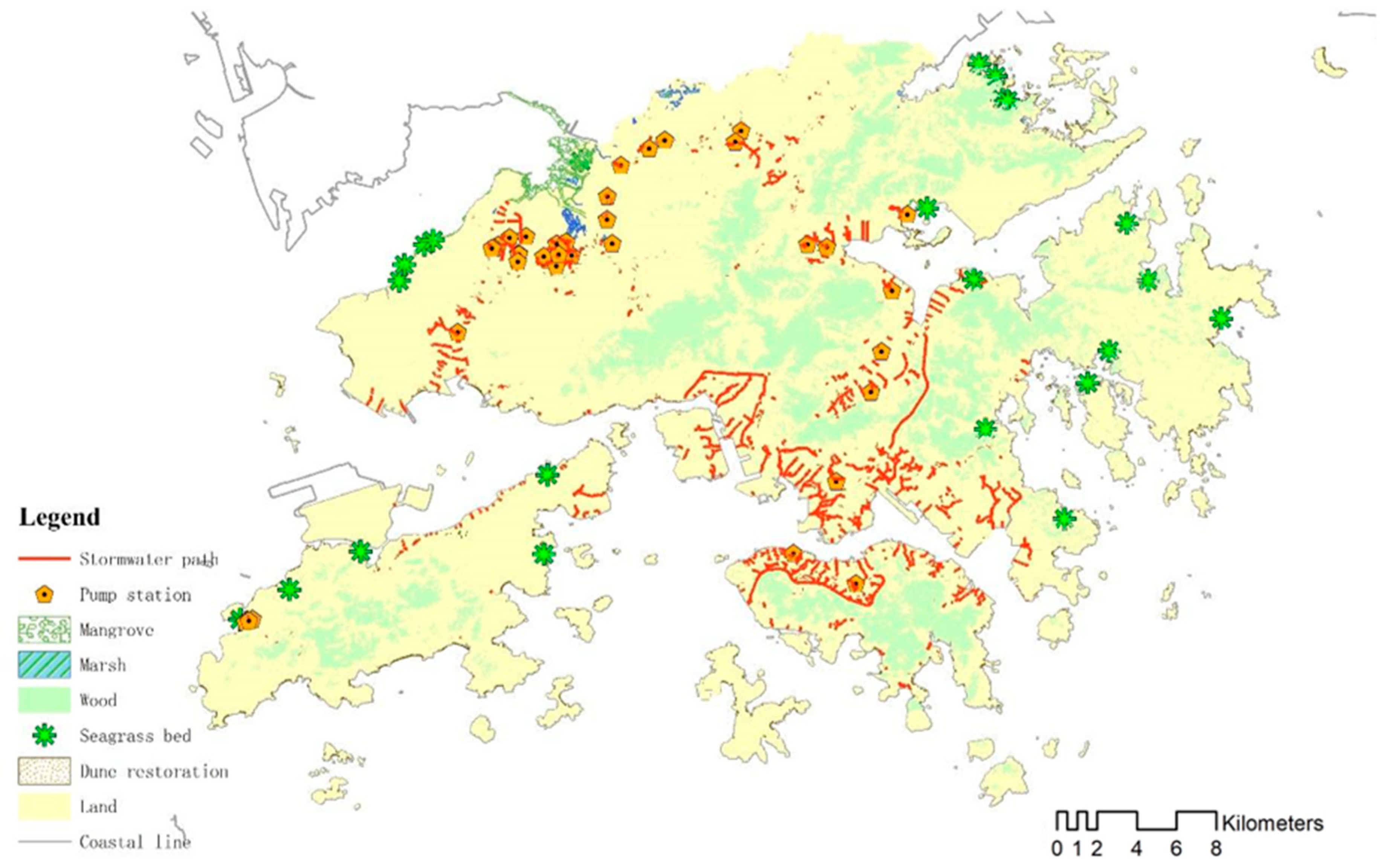
Appendix E
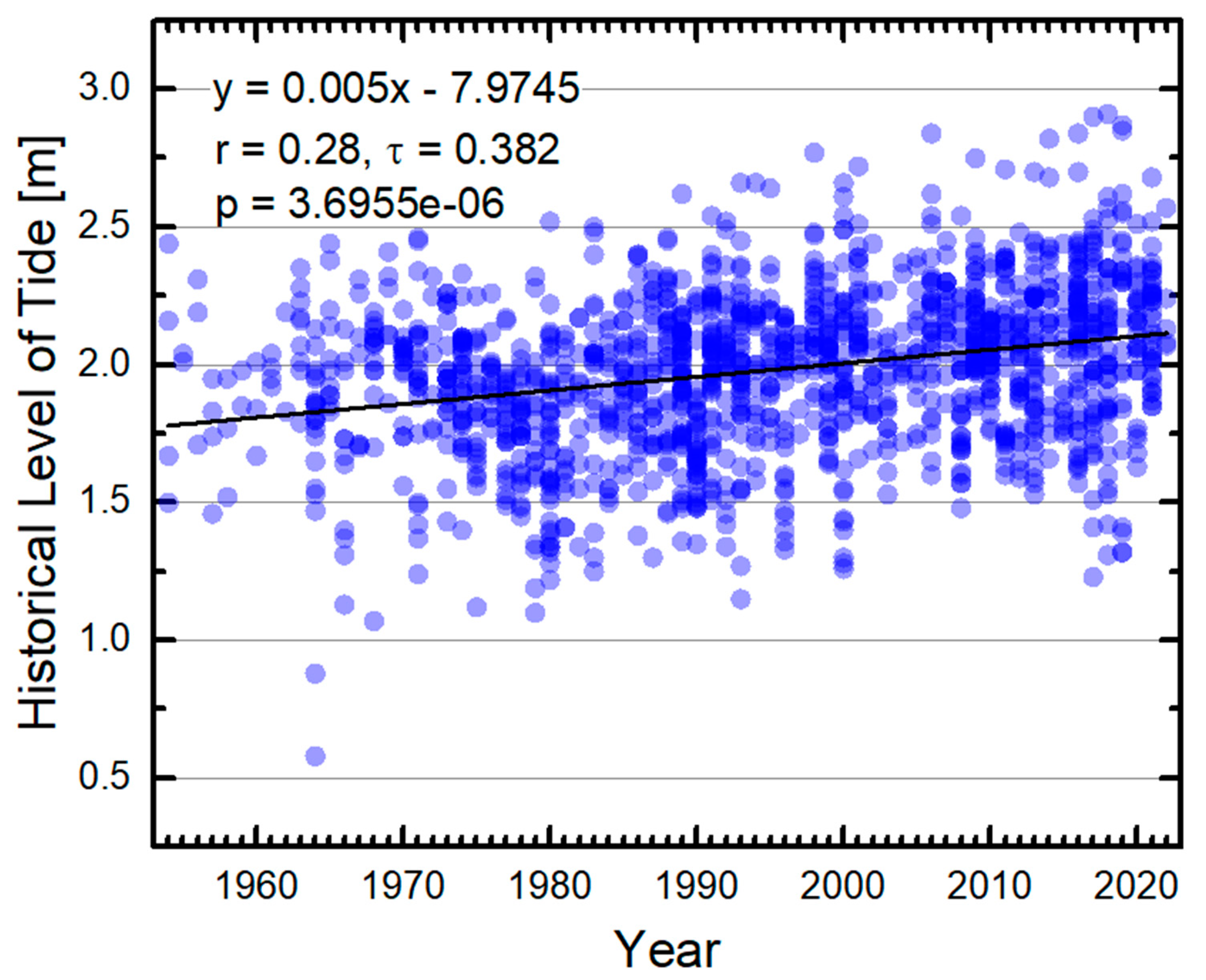
Appendix F

Appendix G
| SSP4.5 | SSP8.5 | ||||
|---|---|---|---|---|---|
| Extreme Sea Level (m) | Frequency of Exceedance (time) | Average Recurrence Interval (years) | Frequency of Exceedance (time) | Average Recurrence Interval (years) | Historical Frequency |
| 3–3.25 | 91.75 | 0.22 | No data | No data | 15.37 |
| 3.25–3.5 | 90.25 | 0.22 | No data | No data | 6.13 |
| 3.5–3.75 | 83.14 | 0.24 | 91.75 | 0.22 | 3.14 |
| 3.75–4 | 66.04 | 0.31 | 87.88 | 0.23 | 1.51 |
| 4–4.25 | 43.95 | 0.46 | 75.90 | 0.26 | 1.14 |
| 4.25–4.5 | 23.85 | 0.88 | 54.68 | 0.37 | 0.89 |
| 4.5–4.75 | 10.50 | 2.02 | 31.84 | 0.65 | 0.64 |
| 4.75–5 | 4.51 | 4.68 | 15.12 | 1.42 | 0.39 |
| 5–5.25 | 2.01 | 10.42 | 6.51 | 3.18 | 0.14 |
| 5.25–5.5 | 1.14 | 17.57 | 3.14 | 6.84 | - |
| 5.5–5.75 | 0.89 | 22.51 | 1.51 | 13.31 | - |
| 5.75–6 | 0.64 | 31.30 | 1.14 | 17.57 | - |
| 6–6.25 | 0.39 | 51.36 | 0.89 | 22.51 | - |
| 6.25–6.5 | 0.14 | 143.07 | 0.64 | 31.30 | - |
| 6.5–6.75 | 0 | - | 0.39 | 51.36 | - |
| 6.75–7 | 0 | - | 0.14 | 143.07 | - |
Appendix H
| Centroids | |||||
| Green_Inf_Score | Constructed_Inf_Score | ||||
| Mean | Std. Deviation | Mean | Std. Deviation | ||
| Cluster | 1 | 0.4645176583 | 0.2512619733 | 0.0605948198 | 0.1339347757 |
| 2 | 0.4350815964 | 0.2505961258 | 0.0463057050 | 0.1214751176 | |
| 3 | 0.5632801059 | 0.0669191738 | 0.0042013062 | 0.0207303980 | |
| 4 | 0.5772796665 | 0.0853719109 | 0.3108347831 | 0.1164582531 | |
| 5 | 0.0589767462 | 0.0999676423 | 0.0079357425 | 0.0274109394 | |
| 6 | 0.0118858385 | 0.0508670896 | 0.3215528210 | 0.1112618549 | |
| 7 | 0.5473243087 | 0.0502970432 | 0.0050557840 | 0.0204797062 | |
| 8 | 0.0493772322 | 0.0939848181 | 0.0063556892 | 0.0244509358 | |
| Combined | 0.2797722611 | 0.2695964133 | 0.0544336122 | 0.1240818137 | |
| Centroids | |||||
| Small Event SSP 4.5 | Large Event SSP 4.5 | ||||
| Mean | Std. Deviation | Mean | Std. Deviation | ||
| Cluster | 1 | 0.9755303378 | 0.1235623460 | 1.0000000000 | 0.0000000000 |
| 2 | 0.3524950927 | 0.0000000000 | 1.0000000000 | 0.0000000000 | |
| 3 | 0.0000000000 | 0.0000000000 | 1.0000000000 | 0.0000000000 | |
| 4 | 0.0000000000 | 0.0000000000 | 0.3586836831 | 0.4419920241 | |
| 5 | 0.0000000000 | 0.0000000000 | 1.0000000000 | 0.0000000000 | |
| 6 | 0.0000000000 | 0.0000000000 | 0.4259523381 | 0.4688937406 | |
| 7 | 0.0000000000 | 0.0000000000 | 0.0478942517 | 0.0588723157 | |
| 8 | 0.0000000000 | 0.0000000000 | 0.0487362778 | 0.0590389025 | |
| Combined | 0.0499900800 | 0.1744467136 | 0.4757952963 | 0.4751547113 | |
| Centroids | |||||
| Small Event SSP 8.5 | Large Event SSP 8.5 | ||||
| Mean | Std. Deviation | Mean | Std. Deviation | ||
| Cluster | 1 | 0.9801540233 | 0.1002145194 | 1.0000000000 | 0.0000000000 |
| 2 | 0.3524950927 | 0.0000000000 | 1.0000000000 | 0.0000000000 | |
| 3 | 0.4748449245 | 0.0000000000 | 0.0230994891 | 0.0000000000 | |
| 4 | 0.0000000000 | 0.0000000000 | 0.0120117396 | 0.0095643814 | |
| 5 | 0.0000000000 | 0.0000000000 | 0.0230994891 | 0.0000000000 | |
| 6 | 0.0000000000 | 0.0000000000 | 0.0124863016 | 0.0101430520 | |
| 7 | 0.0000000000 | 0.0000000000 | 0.0056149324 | 0.0069019571 | |
| 8 | 0.0000000000 | 0.0000000000 | 0.0057136482 | 0.0069214871 | |
| Combined | 0.0591354033 | 0.1923543464 | 0.1096378780 | 0.2942846165 | |
| Centroids | |||||
| Hazard Index SSP 8.5 | Hazard Index SSP 8.5 | ||||
| Mean | Std. Deviation | Mean | Std. Deviation | ||
| Cluster | 1 | 443.4320640 | 383.0951058 | 353.5613576 | 385.8927786 |
| 2 | 97.43114152 | 97.34005910 | 48.92406200 | 67.12296271 | |
| 3 | 1.121440697 | 0.5442923250 | 4.651526525 | 5.816017925 | |
| 4 | 0.4776370161 | 0.5099163045 | 1.200902100 | 2.835063784 | |
| 5 | 1.050332457 | 0.7249202712 | 4.441316414 | 7.541842340 | |
| 6 | 0.4987326510 | 0.5118573014 | 1.312858942 | 2.516747499 | |
| 7 | 02100954671 | 0.3548501279 | 0.1665549074 | 0.5277449115 | |
| 8 | 0.2215145317 | 0.3907466925 | 0.1797211840 | 0.6213871392 | |
| Combined | 18.58141780 | 97.40475880 | 13.91542262 | 84.03370024 | |
| Green_Building | |||||
| 0 | 1 | ||||
| Frequency | Percent | Frequency | Percent | ||
| Cluster | 1 | 687 | 2.5% | 1 | 2.3% |
| 2 | 2066 | 7.4% | 1 | 2.3% | |
| 3 | 4342 | 15.5% | 0 | 0% | |
| 4 | 1288 | 4.6% | 0 | 0% | |
| 5 | 3997 | 14.3% | 0 | 0% | |
| 6 | 2635 | 9.4% | 42 | 95.5% | |
| 7 | 5059 | 18.1% | 0 | 0% | |
| 8 | 7883 | 28.2% | 0 | 0% | |
| Combined | 27,957 | 100.0% | 44 | 100% | |
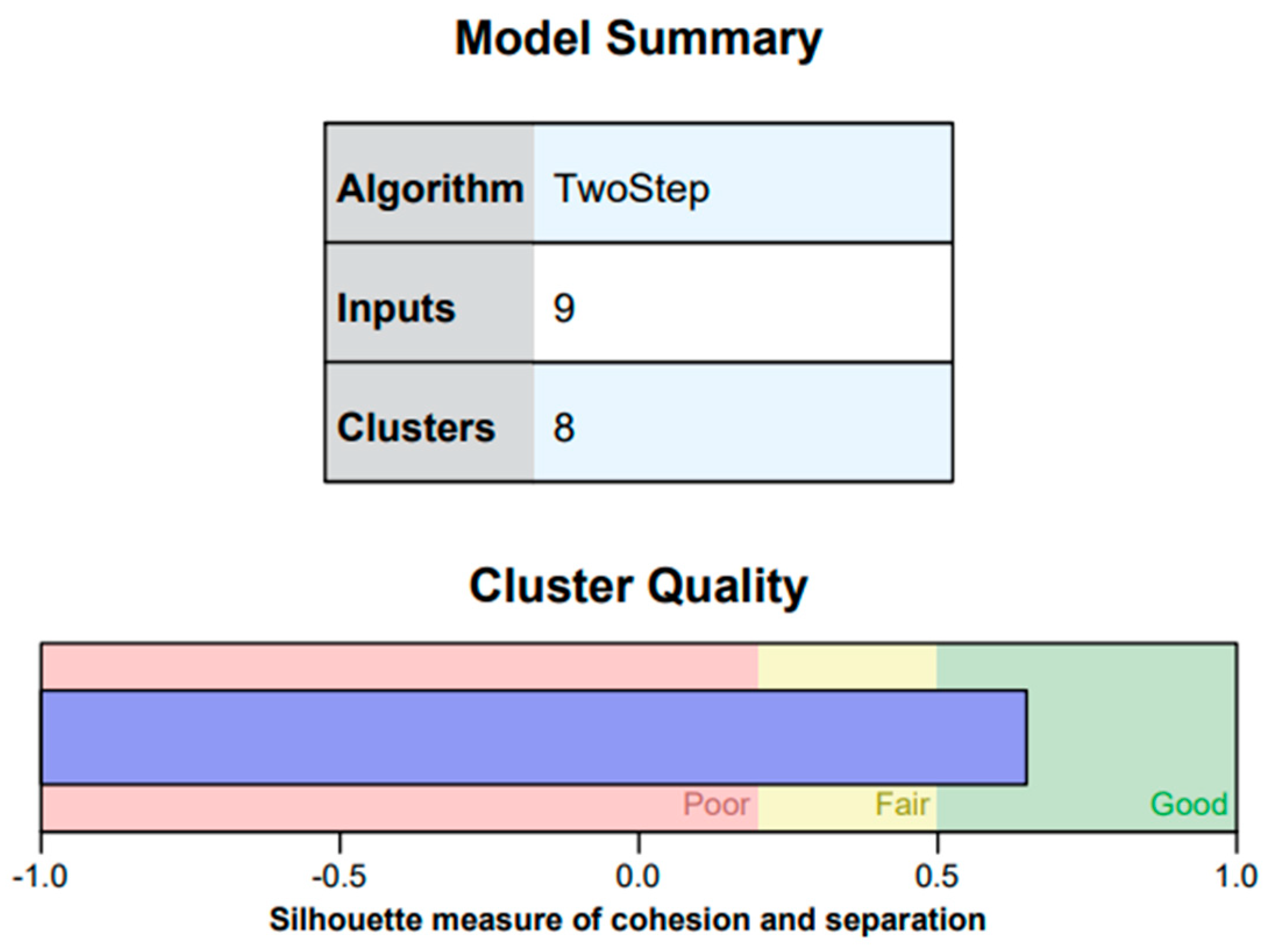
Appendix I
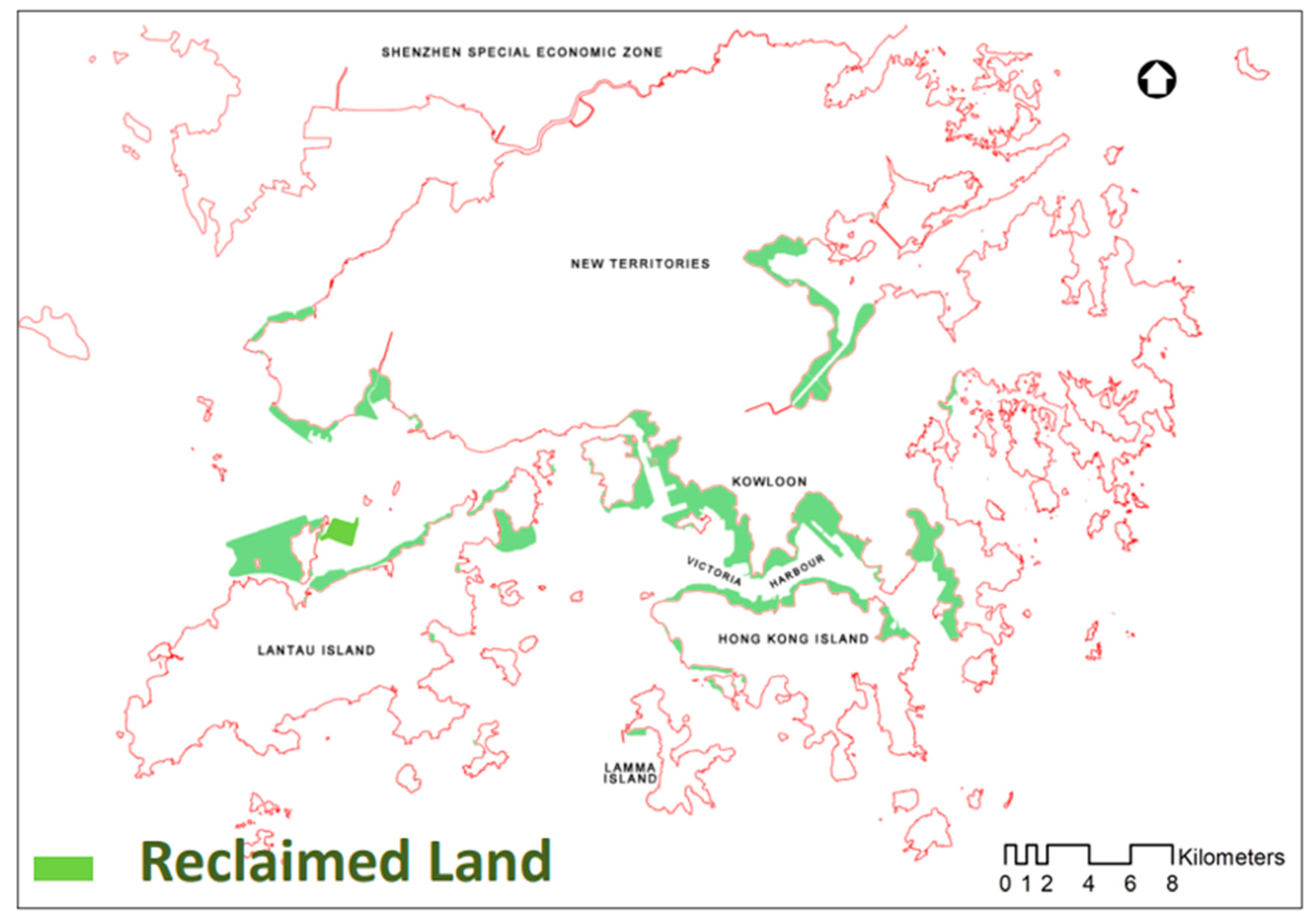
References
- Shah, B.V. Is the environment becoming more hazardous? A global survey 1947 to 1980. Disasters 1983, 7, 202–209. [Google Scholar] [CrossRef]
- Hong Kong Observatory. Global Climate Projections: Tropical Cyclones. Available online: https://www.hko.gov.hk/en/climate_change/proj_global_tc.htm (accessed on 1 September 2022).
- National Oceanic and Atmospheric Administration. Introduction to Storm Surge. Available online: https://www.weather.gov/media/owlie/surge_intro.pdf (accessed on 24 July 2022).
- Drews, C.; Galarneau, T.J., Jr. Directional analysis of the storm surge from hurricane sandy 2012, with applications to Charleston, New Orleans, and the Philippines. PLoS ONE 2015, 10, e0122113. [Google Scholar] [CrossRef]
- Chen, J.; Wang, Z.; Tam, C.; Lau, N.; Lau, D.D.; Mok, H. Impacts of climate change on tropical cyclones and induced storm surges in the Pearl River Delta region using pseudo-global-warming method. Sci. Rep. 2020, 10, 1965. [Google Scholar] [CrossRef]
- Kan, W.S.; Lejano, R.P. How land use, climate change, and an ageing demographic intersect to create new vulnerabilities in Hong Kong. Land 2021, 10, 391. [Google Scholar] [CrossRef]
- Hong Kong Observatory. Storm Surge. Available online: https://www.hko.gov.hk/en/publica/gen_pub/files/storm_surge.pdf (accessed on 24 July 2022).
- Fox-Kemper, B.; Hewitt, H.T.; Xiao, C.; Aðalgeirsdóttir, G.; Drijfhout, S.S.; Edwards, T.L.; Golledge, N.R.; Hemer, M.; Kopp, R.E.; Krinner, G.; et al. Ocean, Cryosphere and Sea Level Change. In Climate Change 2021: The Physical Science Basis. Contribution of Working Group I to the Sixth Assessment Report of the Intergovernmental Panel on Climate Change; Masson-Delmotte, V., Zhai, P., Pirani, A., Connors, S.L., Péan, C., Berger, S., Caud, N., Chen, Y., Goldfarb, L., Gomis, M.I., et al., Eds.; Cambridge University Press: Cambridge, UK, 2021. [Google Scholar]
- Knutson, T.; Camargo, S.J.; Chan, J.C.; Emanuel, K.; Ho, C.H.; Kossin, J.; Mohapatra, M.; Satoh, M.; Sugi, M.; Walsh, K.; et al. Tropical cyclones and climate change assessment: Part II: Projected response to anthropogenic warming. Bull. Am. Meteorol. Soc. 2020, 101, E303–E322. [Google Scholar] [CrossRef]
- Kirezci, E.; Young, I.R.; Ranasinghe, R.; Muis, S.; Nicholls, R.J.; Lincke, D.; Hinkel, J. Projections of global-scale extreme sea levels and resulting episodic coastal flooding over the 21st Century. Sci. Rep. 2020, 10, 11629. [Google Scholar] [CrossRef] [PubMed]
- Hausfather, Z.; Drake, H.F.; Abbott, T.; Schmidt, G.A. Evaluating the performance of past climate model projections. Geophys. Res. Lett. 2020, 47, e2019GL085378. [Google Scholar] [CrossRef]
- Johnson, K.; Depietri, Y.; Breil, M. Multi-hazard risk assessment of two Hong Kong districts. IJDRR 2016, 19, 311–323. [Google Scholar] [CrossRef]
- IPCC. Climate Change 2014: Synthesis Report. Contribution of Working Groups I, II and III to the Fifth Assessment Report of the Intergovernmental Panel on Climate Change; IPCC: Geneva, Switzerland; pp. 117–130.
- The United Nations Office for Disaster Risk Reduction. Proposed Updated Terminology on Disaster Risk Reduction: A Technical Review. Available online: https://www.preventionweb.net/files/45462_backgoundpaperonterminologyaugust20.pdf (accessed on 4 August 2022).
- Chan, F.K.S.; Mitchell, G.; Cheng, X.; Adekola, O.; McDonald, A. Developing a sustainable flood risk appraisal (SFRA) framework for the Pearl River Delta. Environ. Urban. Asia 2013, 4, 301–323. [Google Scholar] [CrossRef]
- Yang, L.; Scheffran, J.; Qin, H.; You, Q. Climate-related flood risks and urban responses in the Pearl River Delta, China. Reg. Environ. Chang. 2015, 15, 379–391. [Google Scholar] [CrossRef]
- Sim, T.; Wang, D.; Han, Z. Assessing the disaster resilience of megacities: The case of Hong Kong. Sustainability 2018, 10, 1137. [Google Scholar] [CrossRef]
- Guo, C.; Sim, T.; Ho, H.C. Impact of information seeking, disaster preparedness and typhoon emergency response on perceived community resilience in Hong Kong. IJDRR 2020, 50, 101744. [Google Scholar] [CrossRef]
- Chan, F.K.S.; Chuah, C.J.; Ziegler, A.D.; Dąbrowski, M.; Varis, O. Towards resilient flood risk management for Asian coastal cities: Lessons learned from Hong Kong and Singapore. J. Clean. Prod. 2018, 187, 576–589. [Google Scholar] [CrossRef]
- Financial Stability Board. Task Force on Climate-Related Financial Disclosures: 2019 Status Report. Available online: https://apo.org.au/node/240501 (accessed on 4 September 2022).
- Surminski, Y.S.; Westcott, M.; Ward, J.; Sayers, P.; Bresch, D.; Clare, B. Be prepared–exploring future climate-related risk for residential and commercial real-estate portfolios. JAI 2020, 23, 24–34. [Google Scholar]
- Jongman, B.; Ward, P.J.; Aerts, J.C. Global exposure to river and coastal flooding: Long term trends and changes. Glob. Environ. Chang. 2012, 22, 823–835. [Google Scholar] [CrossRef]
- Yu, Q.; Lau, A.K.; Tsang, K.T.; Fung, J.C. Human damage assessments of coastal flooding for Hong Kong and the Pearl River Delta due to climate change-related sea level rise in the twenty-first century. Nat. Hazards 2018, 92, 1011–1038. [Google Scholar] [CrossRef]
- Kron, W. Flood risk = hazard × exposure × vulnerability. Water Int. 2005, 30, 58–68. [Google Scholar] [CrossRef]
- Un, G. Living with Risk: A Global Review of Disaster Reduction Initiatives. Available online: https://www.unisdr.org/files/657_lwr1.pdf (accessed on 4 September 2022).
- Bonadonna, C.; Frischknecht, C.; Menoni, S.; Romerio, F.; Gregg, C.E.; Rosi, M.; Biass, S.; Asgary, A.; Pistolesi, M.; Guobadia, D. Integrating hazard, exposure, vulnerability and resilience for risk and emergency management in a volcanic context: The ADVISE model. J. Appl. Volcanol. 2021, 10, 1–34. [Google Scholar] [CrossRef]
- Tiernan, A.; Drennan, L.; Nalau, J.; Onyango, E.; Morrissey, L.; Mackey, B. A review of themes in disaster resilience literature and international practice since 2012. PDP 2019, 2, 53–74. [Google Scholar] [CrossRef]
- Moret, W. Vulnerability Assessment Methodologies: A Review of the Literature; FHI: Washington, DC, USA, 2014. [Google Scholar]
- Fekete, A.; Damm, M.; Birkmann, J. Scales as a challenge for vulnerability assessment. Nat. Hazards 2010, 55, 729–747. [Google Scholar] [CrossRef]
- Paton, D.; Johnston, D. Disaster Resilience: An Integrated Approach; Charles C Thomas Publisher: Springfield, IL, USA, 2017. [Google Scholar]
- Nasiri, H.; Mohd, J.M.Y.; Thamer, A.M.A. An overview to flood vulnerability assessment methods. SWAM 2016, 2, 331–336. [Google Scholar] [CrossRef]
- Keenan, J.M. Adaptive capacity of commercial real estate firms in New York City to urban flooding. J. Water Clim. Chang. 2015, 6, 486–500. [Google Scholar] [CrossRef]
- McNamara, D.E.; Gopalakrishnan, S.; Smith, M.D.; Murray, A.B. Climate adaptation and policy-induced inflation of coastal property value. PloS ONE 2015, 10, e0121278. [Google Scholar] [CrossRef]
- Li, M.; Zhang, F.; Barnes, S.; Wang, X. Assessing storm surge impacts on coastal inundation due to climate change: Case studies of Baltimore and Dorchester County in Maryland. Nat. Hazards 2020, 103, 2561–2588. [Google Scholar] [CrossRef]
- McAlpine, S.A.; Porter, J.R. Estimating recent local impacts of sea-level rise on current real-estate losses: A housing market case study in Miami-Dade, Florida. PRPR 2018, 37, 871–895. [Google Scholar] [CrossRef]
- Conyers, Z.A.; Grant, R.; Roy, S.S. Sea Level Rise in Miami Beach: Vulnerability and Real Estate Exposure. Prof. Geogr. 2019, 71, 278–291. [Google Scholar] [CrossRef]
- Paulik, R.; Stephens, S.; Wild, A.; Wadhwa, S.; Bell, R.G. Cumulative building exposure to extreme sea level flooding in coastal urban areas. IJDRR 2021, 66, 102612. [Google Scholar] [CrossRef]
- Kopp, R.E.; Horton, R.M.; Little, C.M.; Mitrovica, J.X.; Oppenheimer, M.; Rasmussen, D.J.; Strauss, B.H.; Tebaldi, C. Probabilistic 21st and 22nd century sea-level projections at a global network of tide-gauge sites. Earth’s Future 2014, 2, 383–406. [Google Scholar] [CrossRef]
- Katsman, C.A.; Sterl, A.; Beersma, J.J.; Van den Brink, H.W.; Church, J.A.; Hazeleger, W.; Kopp, R.E.; Kroon, D.; Kwadijk, J.; Lammersen, R.; et al. Exploring high-end scenarios for local sea level rise to develop flood protection strategies for a low-lying delta: The Netherlands as an example. Clim. Chang. 2011, 109, 617–645. [Google Scholar] [CrossRef]
- Wang, J.; Gao, W.; Xu, S.; Yu, L. Evaluation of the combined risk of sea level rise, land subsidence, and storm surges on the coastal areas of Shanghai, China. Clim. Chang. 2012, 115, 537–558. [Google Scholar] [CrossRef]
- Tebaldi, C.; Strauss, B.H.; Zervas, C.E. Modelling sea level rise impacts on storm surges along US coasts. Environ. Res. Lett. 2012, 7, 014032. [Google Scholar] [CrossRef]
- Hong Kong Observatory. Mean Sea Level Projection Data for Hong Kong. Available online: https://www.hko.gov.hk/en/climate_change/proj_hk_msl_med_conf_info.htm (accessed on 1 September 2022).
- NOAA National Centers for Environmental Information, Monthly Global Climate Report for December 2021. Available online: https://journals.ametsoc.org/view/journals/bams/103/8/BAMS-D-22-0078.1.xml (accessed on 4 September 2022). [CrossRef]
- Fuller, W.E. Flood flows. Trans. Am. Soc. Civil Eng. 1914, 77, 564–617. [Google Scholar] [CrossRef]
- Selaman, O.S.; Said, S.; Putuhena, F.J. Flood frequency analysis for Sarawak using Weibull, Gringorten and L-moments formula. J. Inst. Eng. 2007, 68, 43–52. [Google Scholar]
- Onen, F.; Bagatur, T. Prediction of flood frequency factor for Gumbel distribution using regression and GEP model. AJSE 2017, 42, 3895–3906. [Google Scholar] [CrossRef]
- Gordon, N.D.; McMahon, T.A.; Finlayson, B.L.; Gippel, C.J.; Nathan, R.J. Stream Hydrology: An Introduction for Ecologists; John Wiley and Sons: New York, NY, USA, 2004. [Google Scholar]
- Makkonen, L. Plotting positions in extreme value analysis. JAMC 2006, 45, 334–340. [Google Scholar] [CrossRef]
- Cook, N. Comments on “Plotting positions in extreme value analysis”. JAMC 2011, 50, 255–266. [Google Scholar] [CrossRef]
- Zennaro, F.; Furlan, E.; Simeoni, C.; Torresan, S.; Aslan, S.; Critto, A.; Marcomini, A. Exploring machine learning potential for climate change risk assessment. Earth Sci. Rev. 2021, 220, 103752. [Google Scholar] [CrossRef]
- Fatho. A New Benchmark in Global Flood Mapping. Available online: https://www.fathom.global/ (accessed on 1 September 2022).
- Climate, X. Global Climate Risk Data Analytics Platform, Developed by Climate Scientists. Available online: https://www.climate-x.com/ (accessed on 1 September 2022).
- Matheswaran, K.; Alahacoon, N.; Pandey, R.; Amarnath, G. Flood risk assessment in South Asia to prioritize flood index insurance applications in Bihar, India. Geomat. Nat. Hazards Risk 2018, 10, 26–48. [Google Scholar] [CrossRef]
- Inyang, U.G.; Akpan, E.E.; Akinyokun, O.C. A hybrid machine learning approach for flood risk assessment and classification. Int. J. Comput. Intell. 2020, 19, 2050012. [Google Scholar] [CrossRef]
- Li, C.; Sun, L.; Jia, J.; Cai, Y.; Wang, X. Risk assessment of water pollution sources based on an integrated k-means clustering and set pair analysis method in the region of Shiyan, China. Sci. Total Environ. 2016, 557, 307–316. [Google Scholar] [CrossRef]
- Khorshidi, N.; Parsa, M.; Lentz, D.R.; Sobhanverdi, J. Identification of heavy metal pollution sources and its associated risk assessment in an industrial town using the K-means clustering technique. Appl. Geochemistry 2021, 135, 105113. [Google Scholar] [CrossRef]
- MacQueen, J. Classification and analysis of multivariate observations. In Proceedings of the 5th Berkeley Symposium on Mathematical Statistics and Probability, Los Angeles, CA, USA, 21 June–18 July 1965 and 27 December 1965–7 January 1966. [Google Scholar]
- Xu, H.; Ma, C.; Lian, J.; Xu, K.; Chaima, E. Urban flooding risk assessment based on an integrated k-means cluster algorithm and improved entropy weight method in the region of Haikou, China. J. Hydrol. 2018, 563, 975–986. [Google Scholar] [CrossRef]
- Warren-Myers, G.; Hurlimann, A. Climate change and risk to real estate. In A Research Agenda for Real Estate; Edward Elgar Publishing: Cheltenham, UK, 2022. [Google Scholar]
- Kron, W.; Steuer, M.; Löw, P.; Wirtz, A. How to deal properly with a natural catastrophe database–analysis of flood losses. NHESS 2012, 12, 535–550. [Google Scholar] [CrossRef]
- Van Der Plank, S.; Brown, S.; Nicholls, R.J. Managing coastal flood risk to residential properties in England: Integrating spatial planning, engineering and insurance. IJDRR 2021, 52, 101961. [Google Scholar] [CrossRef]
- Chandra-Putra, H.; Andrews, C.J. An integrated model of real estate market responses to coastal flooding. J. Ind. Ecol. 2020, 24, 424–435. [Google Scholar] [CrossRef]
- Bunten, D.M.; Kahn, M.E. Optimal real estate capital durability and localized climate change disaster risk. J. Hous. Econ. 2017, 36, 1–7. [Google Scholar] [CrossRef]
- Ruckelshaus, M.H.; Guannel, G.; Arkema, K.; Verutes, G.; Griffin, R.; Guerry, A.; Silver, J.; Faries, J.; Brenner, J.; Rosenthal, A. Evaluating the benefits of green infrastructure for coastal areas: Location, location, location. Coastal Manag. 2016, 44, 504–516. [Google Scholar] [CrossRef]
- Hong Kong Green Building Council. Beam Plus New Building. Available online: https://www.beamsociety.org.hk/files/download/BP_NBv2.0(2021%20Edition)_sc_20220215.pdf (accessed on 18 August 2022).
- Dominicis, M.D.; Wolf, J.; Jevrejeva, S.; Zheng, P.; Hu, Z. Future Interactions Between Sea Level Rise, Tides, and Storm Surges in the World’s Largest Urban Area. Geophys. Res. Lett. 2020, 47, e2020GL087002. [Google Scholar] [CrossRef]
- Drainage Services Department. Stormwater Drainage Manual. Available online: https://www.dsd.gov.hk/EN/Files/Technical_Manual/technical_manuals/Stormwater_Drainage_Manual_Eurocodes.pdf (accessed on 24 August 2022).
- IBM. Choosing a Procedure for Clustering. Available online: https://www.ibm.com/docs/en/spss-statistics/25.0.0?topic=features-choosing-procedure-clustering (accessed on 18 August 2022).
- Sikorska-Senoner, A.E. Clustering model responses in the frequency space for improved simulation-based flood risk studies: The role of a cluster number. J. Flood Risk Manag. 2022, 15, e12772. [Google Scholar] [CrossRef]
- Mwingnè, L.C.D.; Hugues, H.; Marion, A.; Aude, N.; Elodie, R.; Emmanuel, B. Revealing social vulnerability profiles for urban flood management: The case of Ouagadougou (Burkina Faso). Cybergeo 2022. [Google Scholar] [CrossRef]
- World Wildlife Fund. Mai Po Nature Reserve. Available online: https://www.wwf.org.hk/en/wetlands/mai-po/ (accessed on 4 September 2022).
- Zhu, S.; Chwang, A.T. Investigations on the reflection behaviour of a slotted seawall. Coast. Eng. 2001, 43, 93–104. [Google Scholar] [CrossRef]
- Liao, K.H. The socio-ecological practice of building blue-green infrastructure in high-density cities: What does the ABC Waters Program in Singapore tell us? SEPR 2019, 1, 67–81. [Google Scholar] [CrossRef]
- Public Utilities Board. Active Beautiful Clean Waters: Design Guidelines; PUB: Singapore, 2014.

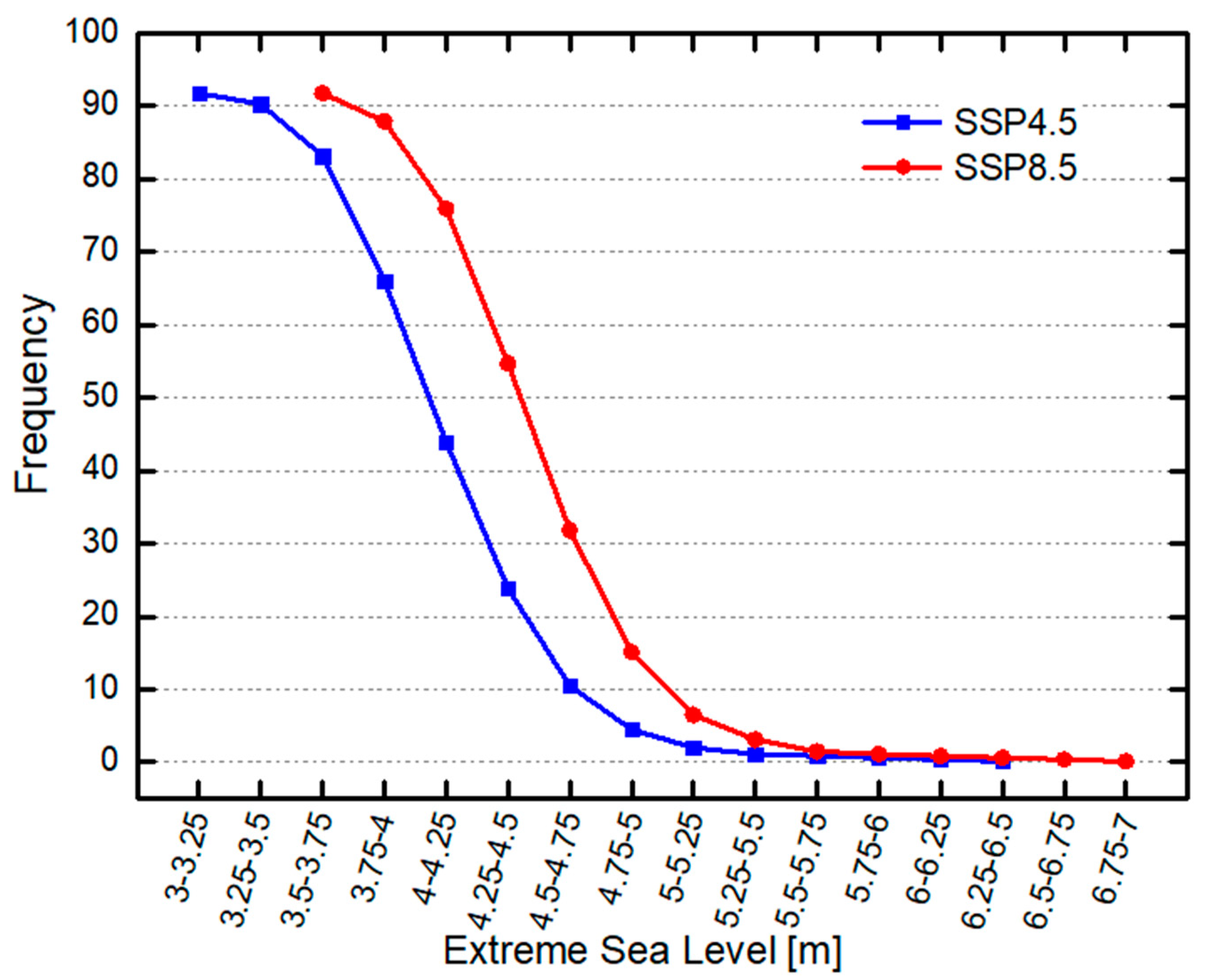

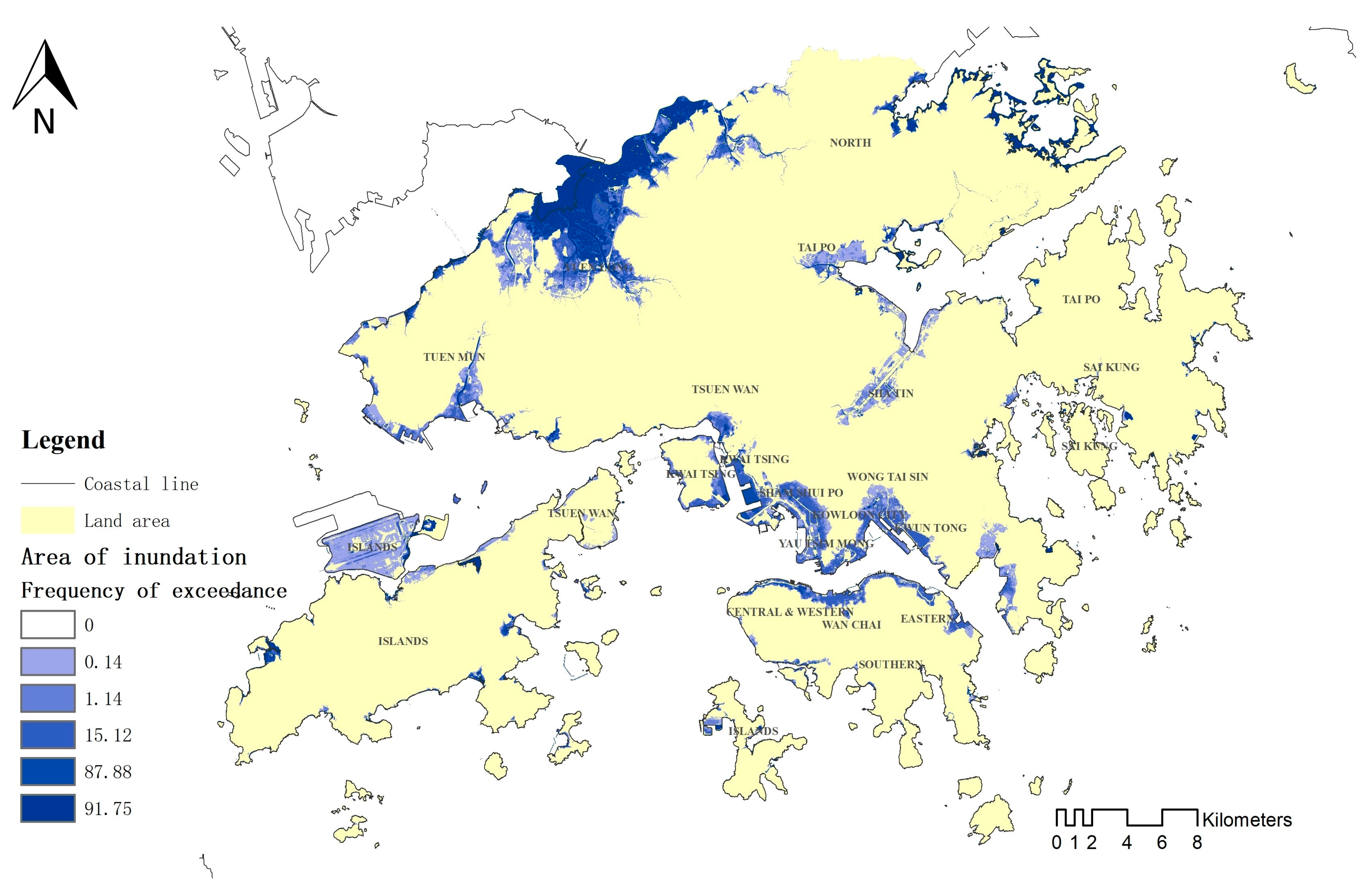

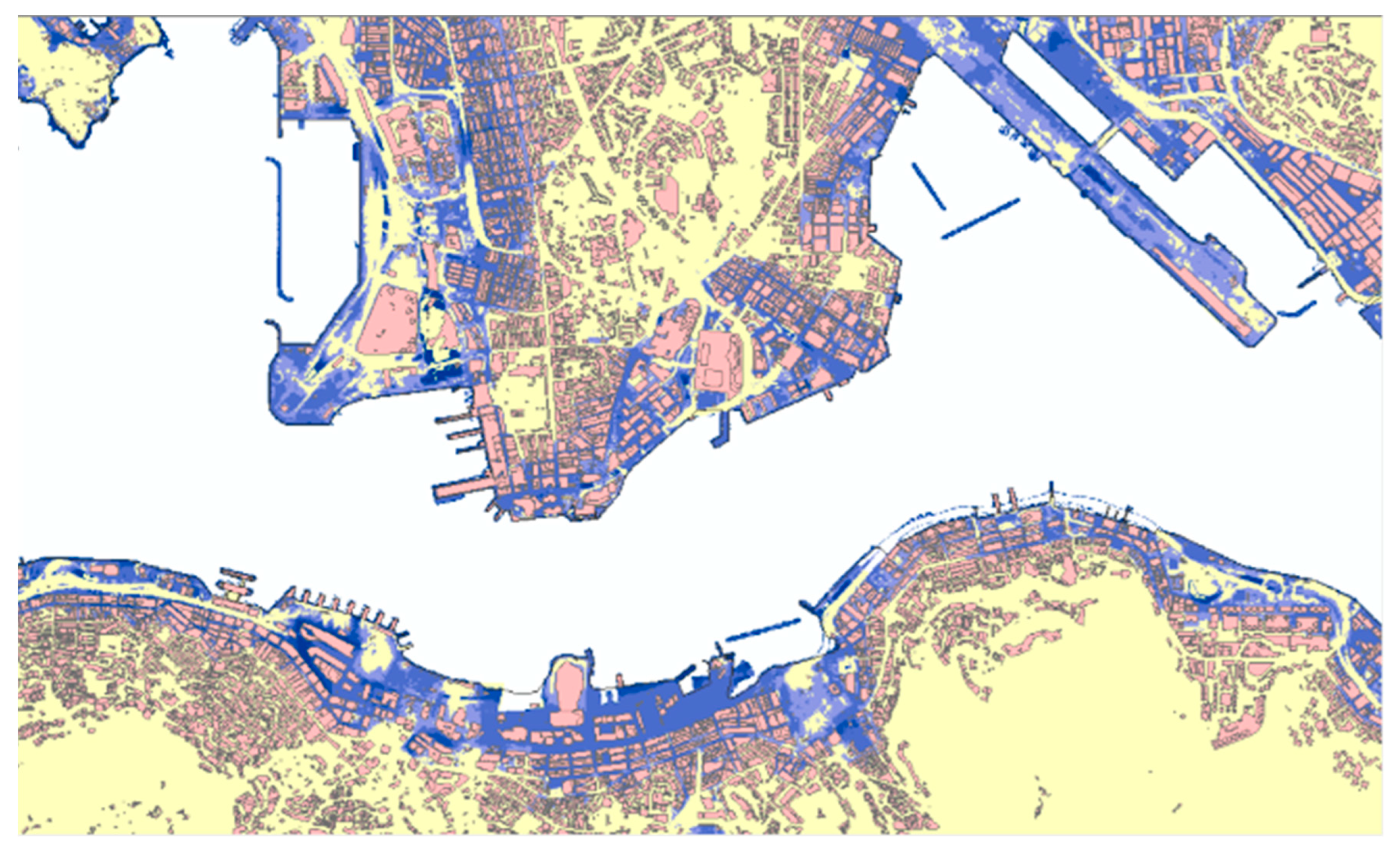
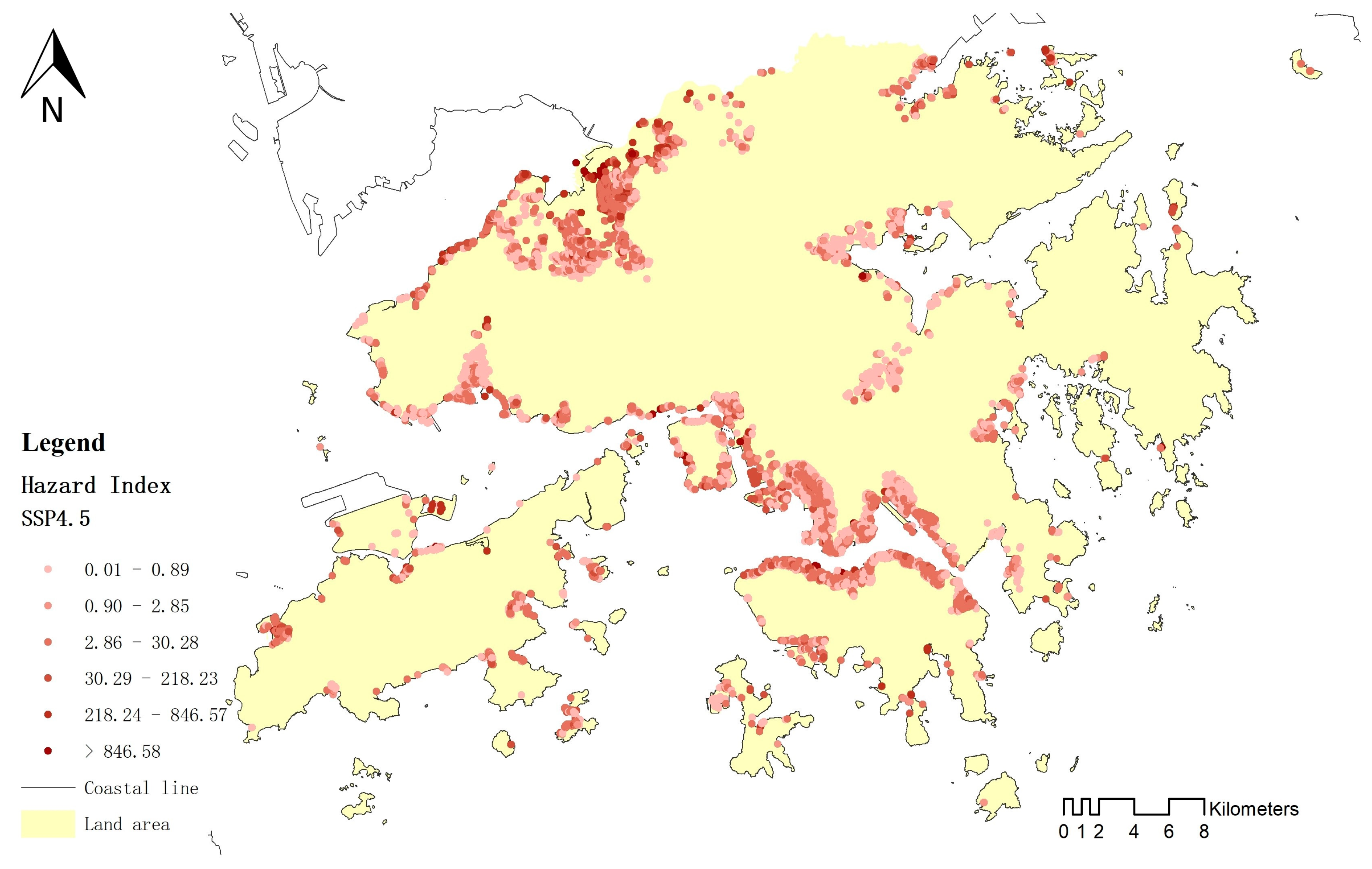

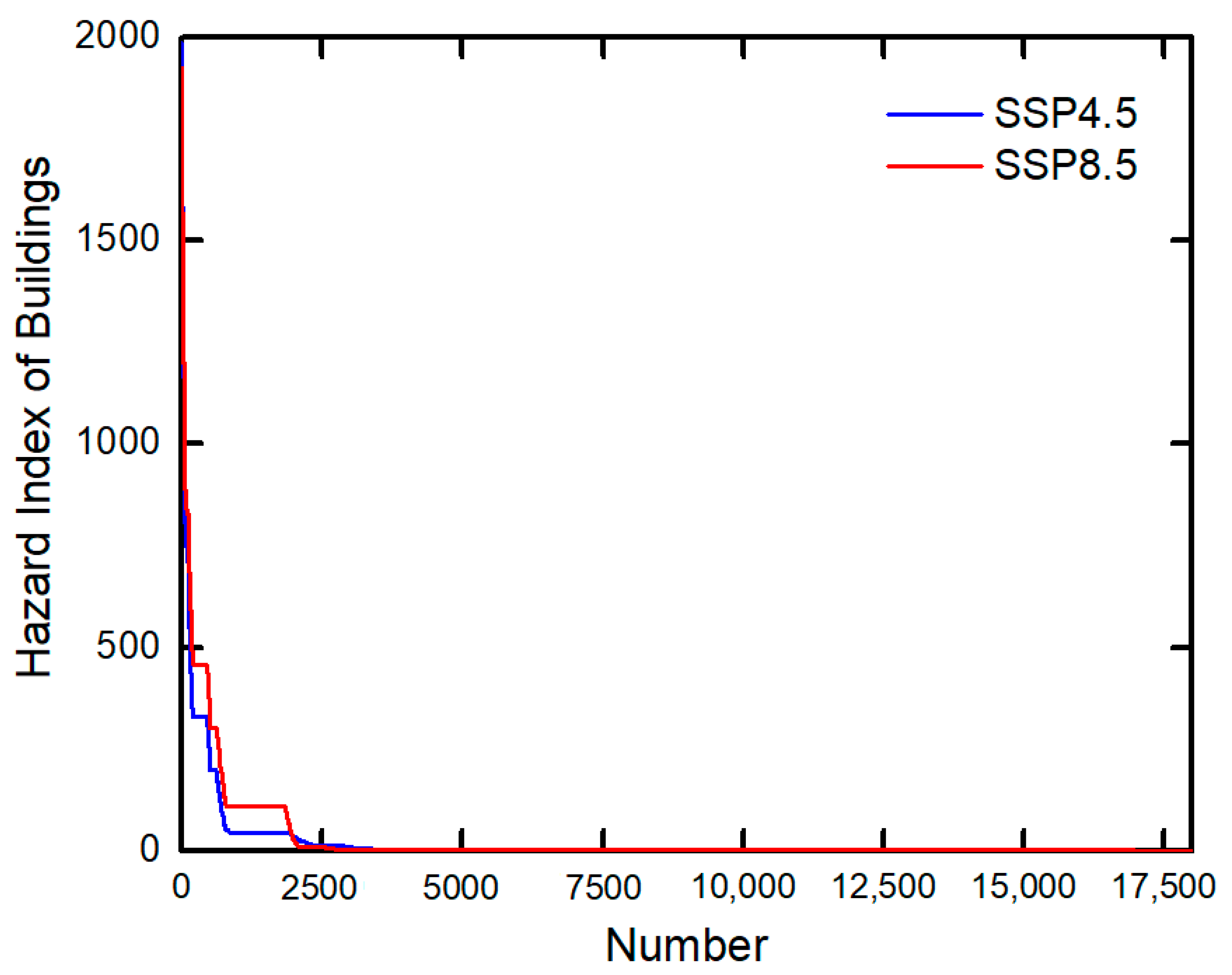

| Criteria | Sub-Criteria | Weighting | |
|---|---|---|---|
| Exposure | Frequency of exceedance | - | - |
| Hazard level | Water depth | - | - |
| Readiness | Flooding control facility | Stormwater path | 1.5 |
| Stormwater pump station | 1.5 | ||
| Green infrastructure | Mangrove | 1.75 | |
| Wood | 1.25 | ||
| Marsh and wetland | 1 | ||
| Seagrass bed | 0.75 | ||
| Dune restoration area | 0.75 | ||
| Green building | - | 1.5 |
| Method | Analysis | Software | Data Type | |
|---|---|---|---|---|
| Quantitative | Statistics | Modelling hazard data | Excel | Climate data |
| GIS analysis | Spatial analysis | ArcGIS | Local geographic data | |
| ML | Cluster analysis | SPSS | Risk data | |
| Qualitative | Results and desktop research for discussion | - | - | |
| N | % of Combined | % of Total | ||
|---|---|---|---|---|
| Cluster | 1 | 688 | 2.5% | 2.5% |
| 2 | 2067 | 7.4% | 7.4% | |
| 3 | 4342 | 15.5% | 15.5% | |
| 4 | 1288 | 4.6% | 4.6% | |
| 5 | 3997 | 14.3% | 14.3% | |
| 6 | 2677 | 9.6% | 9.6% | |
| 7 | 5059 | 18.1% | 18.1% | |
| 8 | 7883 | 28.2% | 28.2% | |
| Combined | 28,001 | 100% | 100% | |
| Total | 28,001 | 100% |
Disclaimer/Publisher’s Note: The statements, opinions and data contained in all publications are solely those of the individual author(s) and contributor(s) and not of MDPI and/or the editor(s). MDPI and/or the editor(s) disclaim responsibility for any injury to people or property resulting from any ideas, methods, instructions or products referred to in the content. |
© 2023 by the authors. Licensee MDPI, Basel, Switzerland. This article is an open access article distributed under the terms and conditions of the Creative Commons Attribution (CC BY) license (https://creativecommons.org/licenses/by/4.0/).
Share and Cite
Singh, M.; Cai, X. Coastal Flooding Hazard, Exposure, and Readiness of Buildings in Hong Kong in 2080–2100, and the Implications for Real Estate Management. ISPRS Int. J. Geo-Inf. 2023, 12, 86. https://doi.org/10.3390/ijgi12030086
Singh M, Cai X. Coastal Flooding Hazard, Exposure, and Readiness of Buildings in Hong Kong in 2080–2100, and the Implications for Real Estate Management. ISPRS International Journal of Geo-Information. 2023; 12(3):86. https://doi.org/10.3390/ijgi12030086
Chicago/Turabian StyleSingh, Minerva, and Xin Cai. 2023. "Coastal Flooding Hazard, Exposure, and Readiness of Buildings in Hong Kong in 2080–2100, and the Implications for Real Estate Management" ISPRS International Journal of Geo-Information 12, no. 3: 86. https://doi.org/10.3390/ijgi12030086
APA StyleSingh, M., & Cai, X. (2023). Coastal Flooding Hazard, Exposure, and Readiness of Buildings in Hong Kong in 2080–2100, and the Implications for Real Estate Management. ISPRS International Journal of Geo-Information, 12(3), 86. https://doi.org/10.3390/ijgi12030086






